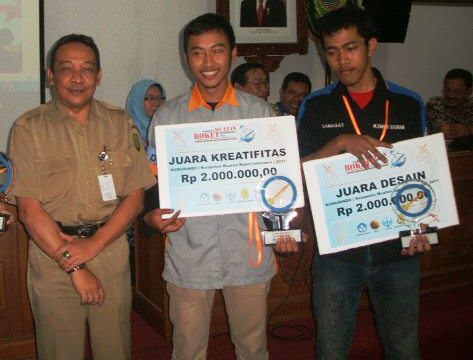ITB Won Most Creative Award in National Rocket Payload Competition
By UKM Student English Forum
Editor UKM Student English Forum

 Komurindo 1BANDUNG, itb.ac.id - Team Eletron Legacy from Bandung Institute of Technology has successfully grabbed the most creative award in the National Rocket Payload Competition (KOMURINDO) 2011 last June. Held in Pandasimo Beach, Bantul, in the Special Region of Yogyakarta, the competition hosted 40 teams from 36 universities throughout Indonesia.
Komurindo 1BANDUNG, itb.ac.id - Team Eletron Legacy from Bandung Institute of Technology has successfully grabbed the most creative award in the National Rocket Payload Competition (KOMURINDO) 2011 last June. Held in Pandasimo Beach, Bantul, in the Special Region of Yogyakarta, the competition hosted 40 teams from 36 universities throughout Indonesia.
Team Electron Legacy consisted of three students, all hailing from the School of Electrical and Informatics Engineering (STEI); Syarif Rousyan Fiksi (Electrics '07), Ichsan Mulia Permata (Electrics '07), and Tigor Christian (Electrics '08).
This year's theme for the competition is Attitude Monitoring and Surveillance. Every team was given a rocket equipped with a payload. The challenge is to control the behavior of the rocket with the given payload.
The payloads were designed to be capable of measuring certain values that indicate the rocket's behavior, such as the motion direction and acceleration. In order to fulfill such role, the payload is equipped with various sensors such as an accelerometer, a digital compass, and a gyroscope. A microprocessor was also attached so that the data received by the rockets can be transmitted through radio wave.
The competition comprised of three test stages. The first step was payload functionality and integrity, where the rocket is tested against effects that are common during launch such as G-Shock, G-Force, and vibration.
The next test observes the rocket's behavior during flight. Data sent from the transmitter during the first 12 seconds since launch are stored and then judged.
Besides being able to send data on the rocker's behavior, the payload is also designed to detach itself from the rocket once the deisgnated target is reached. The payload will then take a picture when it is still on flight. This picture-taking feature determines the surveillance capability of the payload, as it would have to operate on an acceleration of 10G. Participants then present and elaborate the data they acquired during the tests.
Image source: documentary by Elian Daiva
This year's theme for the competition is Attitude Monitoring and Surveillance. Every team was given a rocket equipped with a payload. The challenge is to control the behavior of the rocket with the given payload.
The payloads were designed to be capable of measuring certain values that indicate the rocket's behavior, such as the motion direction and acceleration. In order to fulfill such role, the payload is equipped with various sensors such as an accelerometer, a digital compass, and a gyroscope. A microprocessor was also attached so that the data received by the rockets can be transmitted through radio wave.
The competition comprised of three test stages. The first step was payload functionality and integrity, where the rocket is tested against effects that are common during launch such as G-Shock, G-Force, and vibration.
The next test observes the rocket's behavior during flight. Data sent from the transmitter during the first 12 seconds since launch are stored and then judged.
Besides being able to send data on the rocker's behavior, the payload is also designed to detach itself from the rocket once the deisgnated target is reached. The payload will then take a picture when it is still on flight. This picture-taking feature determines the surveillance capability of the payload, as it would have to operate on an acceleration of 10G. Participants then present and elaborate the data they acquired during the tests.
Image source: documentary by Elian Daiva

.jpg)

.jpg)
.jpg)
.jpg)
